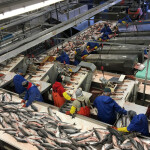The seafood industry has work to do if it wants to capitalize on shifting trends in foodservice in the United States, according to a presentation by Warren Solochek, president of food service division of NPD Group, at the National Fisheries Institute’s Global Seafood Market Conference in San Francisco, California on Tuesday, 17 January.
Americans are eating out less, and new products and services such as meal-kits and a wider range of home delivery offerings are changing the way food enters American households, Solochek said.
“As Americans, we have a lot of new places to source our food, and some of those are really beneficial to seafood,” he said.
For example, meal-kits such as Blue Apron solve many of the problems Americans cite for not buying seafood – particularly, it makes preparation and cooking easier and less stressful and it allows consumers to try new types and preparations of seafood. Meal-kits are also associated, along with seafood, with healthiness and the “slow-food” movement, Solochek said.
“Meal-kits are a great opportunity for seafood,” he said. “Currently, there are not a lot of companies involved; I would suggest you check them out.”
Meal-kits are just one encouraging trend pushing seafood onto the plates of a key demographic: millennials.
“If you can get people to eat fish when they are younger, they will continue to eat fish when they are older,” Solochek said.
Retail outlets, convenience store chains and restaurants are all making moves to bolster their attractiveness to millennials, all of which can by capitalized on by the seafood sector, he said. Grocery stores and convenience stores have committed to offering more prepared foods, another attractive option for customers who may be interested in eating seafood but are afraid to cook it.
Restaurants have also changed their approach to millennials, increasing sales of both to-go and delivered meals. According to Solochek, the number of food sold through delivery has gone up four percent in the past five years, the equivalent of 1.7 billion meals annually.
“This could be great for seafood, or this could be really problematic, because how well does seafood carry?” Solochek said.
Despite the lucrative potential of millennials, the average U.S. consumer of seafood is overwhelmingly older, richer and higher education, according to NPD research. Eighty-one percent of seafood consumption in the United States is done by those 55 and older.
American seafood-eaters are also mostly from the Southeast, with 42 percent of seafood sales taking place in there, while 22 percent is sold in the Midwest, 19 percent in the Northeast and 18 percent in the West.
As to whether it is possible to improve public opinion on seafood, Solochek offered a qualified but positive response.
“The answer is yes, it is possible to change public opinion on seafood. But it’s going to take a while,” he said. “There are opportunities, for example, to get people to take a bigger portion of fish and then reheat it later. That in itself is a big issue. There needs to be an effort to convince people that three days later, that piece of fish is still going to be safe to eat.”






